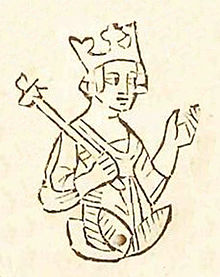| Agnes of Austria | |
|---|---|
 Agnes by Anton Boys Agnes by Anton Boys | |
| Queen consort of Hungary | |
| Tenure | 1296–1301 |
| Born | 18 May 1281 |
| Died | 10 June 1364 (aged 83) Königsfelden, County of Tyrol, Holy Roman Empire |
| Burial | Königsfelden Monastery, County of Tyrol, Holy Roman Empire |
| Spouse | Andrew III of Hungary |
| House | Habsburg (by birth) Árpád (by marriage) |
| Father | Albert I of Germany |
| Mother | Elisabeth of Tirol |
Agnes of Austria (18 May 1281 – 10 June 1364) was Queen of Hungary by marriage to Andrew III of Hungary.
Life

Agnes was a daughter of Albert I of Germany and his wife Elisabeth of Tirol. She was Queen of Hungary by marriage. She was a member of the House of Habsburg.
Queen
On 13 February 1296 in Vienna, Agnes married Andrew III of Hungary. Afterwards, with his father-in-law's support, Andrew managed to defeat the revolt of Miklós Kőszegi and Máté Csák III, and occupy the castles of Kőszeg and Pozsony. In 1298 Andrew supported with troops his father-in-law's revolt against King Adolf of Germany.
Agnes disliked tournaments, but liked sermons. Since she was small of stature, she used to wear dresses her sisters no longer wanted, which gained her praise for modesty.
The death of Andrew III on 14 January 1301, at Buda, ended the male line of the Árpáds. Stephen Ákos, one of his contemporaries called him "the last golden twig of the Árpáds".
Later life
At that point, Agnes was a widow and she had no children to carry on the Árpád dynasty. However she was only 19 so was still able to remarry and have children but she never did. Agnes became a patroness of Königsfelden Monastery in the County of Tyrol, which had been founded by her mother in memory of her late husband. Agnes took her stepdaughter Elizabeth with her and went to live there in a small house near the monastery. She was one of the final members of the Arpad family. Elizabeth was expected to marry Wenceslaus III of Bohemia, but the wedding never happened since Wenceslaus instead married Viola Elisabeth of Cieszyn. Left free, she became a Dominican nun at the nearby Töss Monastery, where she gained a reputation for holiness.
Agnes was depicted as pious. On the other hand, according to the 16th century Chronicon helveticum of Aegidius Tschudi, she avenged her father's murder by ordering the execution and expulsion of 1000 people (families and followers of his murderers), but it appears this report was to a large extent based on Swiss anti-Habsburg propaganda. Because of her good reputation, she was asked several times to act as mediator. In 1333, she established a treaty between Austria and a number of Swiss towns and regions during the Gümmenenkrieg. In 1351, she solved a dispute between Basel and Bremen and did the same in the same year for Albert II, Duke of Austria and the Swiss Confederacy. Her brothers often came to see her in Königsfelden to ask for advice.
The Book of Divine Consolation written by Meister Eckhart was likely partially intended as a gift for Agnes. In the book the author aims to console the reader and gives around 30 reasons why a person should not be saddened by any unfortune.
Agnes died on 10 June 1364 at Königsfelden, and was buried in the nuns' cemetery of Königsfelden Monastery.
Ancestry
| Ancestors of Agnes of Austria (1281–1364) | |||||||||||||||||||||||||||||||||||||||||||||||||||||||||||||||||||||||||||||||||||||||||||||||||||||||||||||||||||||||||||||||||||||||||||||||||||||||||||||||||||||||||||||||||||||||||||||||||||||||||||||||||||||||||||||||||||||||||||||||||||||||||||||||||||||||||||||||||||||||||
|---|---|---|---|---|---|---|---|---|---|---|---|---|---|---|---|---|---|---|---|---|---|---|---|---|---|---|---|---|---|---|---|---|---|---|---|---|---|---|---|---|---|---|---|---|---|---|---|---|---|---|---|---|---|---|---|---|---|---|---|---|---|---|---|---|---|---|---|---|---|---|---|---|---|---|---|---|---|---|---|---|---|---|---|---|---|---|---|---|---|---|---|---|---|---|---|---|---|---|---|---|---|---|---|---|---|---|---|---|---|---|---|---|---|---|---|---|---|---|---|---|---|---|---|---|---|---|---|---|---|---|---|---|---|---|---|---|---|---|---|---|---|---|---|---|---|---|---|---|---|---|---|---|---|---|---|---|---|---|---|---|---|---|---|---|---|---|---|---|---|---|---|---|---|---|---|---|---|---|---|---|---|---|---|---|---|---|---|---|---|---|---|---|---|---|---|---|---|---|---|---|---|---|---|---|---|---|---|---|---|---|---|---|---|---|---|---|---|---|---|---|---|---|---|---|---|---|---|---|---|---|---|---|---|---|---|---|---|---|---|---|---|---|---|---|---|---|---|---|---|---|---|---|---|---|---|---|---|---|---|---|---|---|---|---|---|---|---|---|---|---|---|---|---|---|---|---|---|---|---|---|---|
| |||||||||||||||||||||||||||||||||||||||||||||||||||||||||||||||||||||||||||||||||||||||||||||||||||||||||||||||||||||||||||||||||||||||||||||||||||||||||||||||||||||||||||||||||||||||||||||||||||||||||||||||||||||||||||||||||||||||||||||||||||||||||||||||||||||||||||||||||||||||||
References
- ^ Duggan, Anne (1997). Queens and Queenship in Medieval Europe. Woodbridge: The Boydell Press. p. 112.
- Honemann, Volker 'A Medieval Queen and her Stepdaughter', p. 112.
- Duggan, Anne (1997). p. 114.
- Spamer, Adolf (1909-01-01). "ZUR Überlieferung Der Pfeiffer'schen Eckeharttexte". Beiträge zur Geschichte der Deutschen Sprache und Literatur (PBB) (in German). 34 (Jahresband): 307–420. doi:10.1515/bgsl.1909.1909.34.307. ISSN 1865-9373.
- Strauch, Philipp (1922). Meister Eckarts Buch der göttlichen Tröstung und von dem edlen Menschen (Liber Bendictus) (Kleine Texte für Vorlesungen und Übungen, 35, Band 35). De Gruyter. p. 2. ISBN 978-3111291260.
External links
- Henry Gardiner Adams, ed. (1857). "Agnes of Hungary". A Cyclopaedia of Female Biography: 14. Wikidata Q115376106.
| Agnes of Austria (1281–1364) House of HabsburgBorn: 1281 Died: 1364 | ||
| Royal titles | ||
|---|---|---|
| Preceded byFenenna of Kuyavia | Queen consort of Hungary 1296–1301 |
Succeeded byViola Elisabeth of Cieszyn |
- 1281 births
- 1364 deaths
- 13th-century House of Habsburg
- 14th-century House of Habsburg
- Queens consort of Hungary
- Burials at Königsfelden Monastery
- 13th-century Austrian women
- 14th-century Austrian women
- 14th-century Austrian people
- 13th-century Hungarian women
- 14th-century Hungarian women
- 13th-century Hungarian people
- 14th-century Hungarian people
- People from the Duchy of Austria
- Royal reburials
- Daughters of kings
- Daughters of dukes